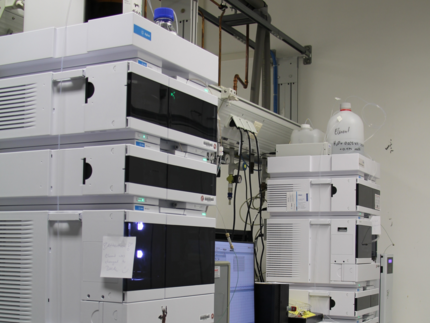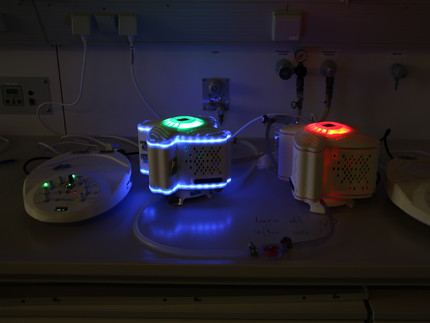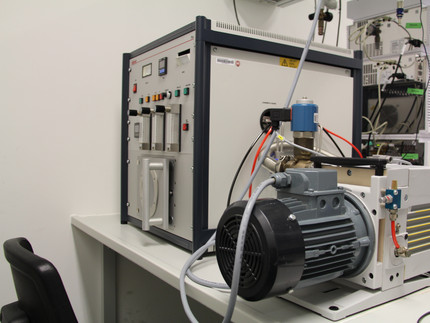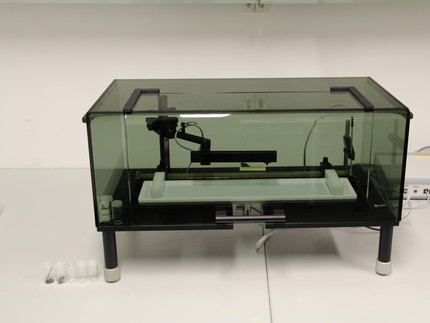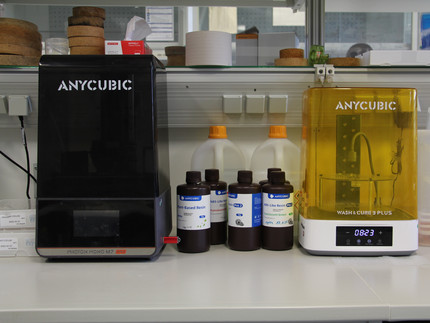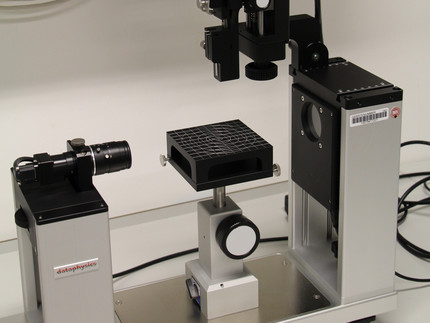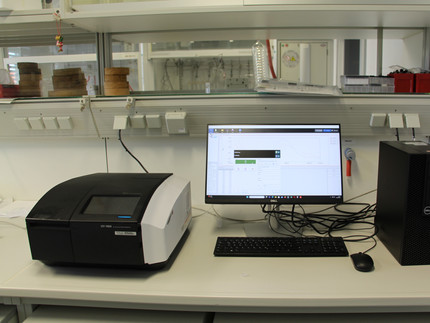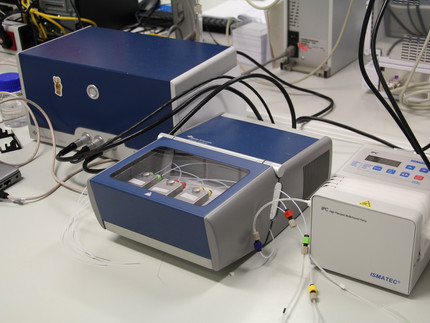Instruments available in the group
Aqueous SEC (Freddie):
This system features an autosampler, column oven, UV-Vis, refractive index (RI), and MALLS detectors. It utilizes 300 × 8 mm² PSS NOVEMA Max columns, operating with an aqueous eluent of 0.1 M NaCl containing 0.025 vol% formic acid at a flow rate of 1.0 mL·min⁻¹. Optimized for analyzing cationic (co)polymers, it offers reliable size distribution across a wide molecular weight range. It’s affectionately known as Freddie—named after Freddie Mercury—for the flamboyant flair with which it maneuvers its sample gripper.
Organic SEC (Brian) :
Complementing Freddie, our second SEC system is configured for organic-phase separations currently using N,N-Dimethylacetamide (DMAC) as the eluent, in 0.25M NH4Ac. This setup is particularly suitable for analyzing neutral and hydrogen bonding polymers, such as polyacrylates, polyesters, and other high-performance materials. Brian (after Brian May) shares the same detector suite—autosampler, RI, UV-Vis, but not MALLS—and expands our capability to characterize polymers across a broader chemical spectrum.
Contact: Tom or Heliya
Photoreactors – PhotoCube™ by ThalesNano
Our photochemical platform features two advanced LED-based photoreactors, affectionately named Luigi and Luise, inspired by Giacomo Luigi Ciamician—one of the founding figures of photochemistry.
Luigi
The original PhotoCube™ system offers high-power irradiation across 8 selectable wavelengths: 365 nm, 395 nm, 457 nm, 500 nm, 523 nm, 595 nm, 623 nm, and a broad-spectrum white light mixture. Each LED module delivers power outputs up to 128 W per channel, with measured light intensities reaching ~400 mW·cm⁻² for blue light at the sample position. Up to three wavelengths can be combined simultaneously, and power levels are individually tunable for precise control over reaction conditions. The system supports up to eight reaction vials or a single 50 mL round-bottom flask, with active air cooling to maintain consistent thermal profiles.
Luise
Our second PhotoCube™ reactor, Luise, is equipped with the same modular architecture and wavelength options, enabling parallel or orthogonal photochemical workflows. Luise matches Luigi in performance and flexibility, doubling our capacity for light-driven transformations.
Plasma Cleaner
Our plasma cleaner from Electronic Diener Plasma Surface Technology enables efficient and controlled surface treatment using low-pressure plasma. The system supports both oxygen and air plasma modes for cleaning, activation, and modification of a wide range of substrates including polymers, glass, and metals. It is ideal for preparing surfaces for bonding, coating, or analytical measurements by removing organic contaminants and increasing surface energy.we mostly use it for cleaning our QCMD sensors as a clean sensor is crucial in that technique.
contact: Anahita
Langmuir Trough
The LangmuirTrough (named Ivan) is designed for surface interaction and adhesion studies, enabling the measurement of interfacial forces, coating adhesion, or material response under controlled conditions.
Its robust design and flexible operation make it a valuable tool for probing surface energy, adhesion strength, or mechanical interactions at the micro and nanoscale.
One specific use is tp probe the interaction of water soluble polymers with lipid monolayers.
Contact: Alain
3D printer
The Photon Mono M7 Pro is a high-precision resin 3D printer designed for professionals and enthusiasts who demand exceptional detail and reliability. Featuring a large build volume and ultra-fast printing speeds, it delivers crisp, accurate models with minimal layer lines. Its advanced monochrome screen ensures longer lifespan and consistent performance, making it ideal for prototyping, miniatures, and functional parts. We use it specifically for prototyping, for instance in building customized photoreactors.
Contact Angle Device
The DataPhysics OCA 11 is a precise contact angle and surface tension measuring instrument, designed for reliable analysis of wetting, adhesion, and interfacial properties. It provides high-resolution imaging and automated measurement capabilities, ensuring accurate and repeatable results. Widely used in material science, coatings, and surface chemistry, it delivers powerful insights into surface interactions for both research and industrial applications.
UV-VIS Spectrometer
The UV-Vis 1900 Spectrophotometer offers fast, precise, and reliable measurements across a wide spectral range. With an intuitive touchscreen interface and compact design, it ensures easy operation while maintaining high accuracy. Ideal for research, quality control, and teaching laboratories, it combines advanced optics with user-friendly features for versatile applications.
Quartz Crystal Microbalance with Dissipation Monitoring (QCM-D – Quantum Design)
Our QCM-D system from Quantum Design provides high-sensitivity, real-time analysis of mass and viscoelastic changes at interfaces, ideal for exploring thin films, adsorption processes, and biomolecular interactions. Utilizing quartz crystal sensors, the instrument simultaneously tracks frequency and dissipation shifts, enabling precise insights into both mass uptake and mechanical properties of surface-bound materials.
The system supports operation in both liquid and ambient environments and is currently equipped with gold-coated and silicone-coated sensor crystals, allowing for versatile application across a range of soft materials, polymers, and biological systems.
As special add one we have 4 sample chambers with transparent top parts to monitor surfaces under irradiation.
Contact: Anahita

